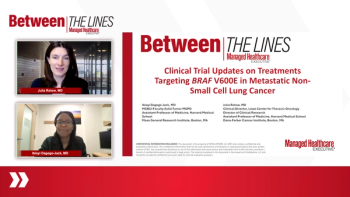
Overview of Originator Biologics, Biosimilars, and Unbranded Biologics
Definitions of originator biologics, biosimilars, and unbranded biologics, including their lifespan in the marketplace.
Episodes in this series

Timothy O’Shea, PharmD, MS: An originator biologic is the original or first biologic that is approved by the FDA [US Food and Drug Administration] and ultimately makes its way to market. Biologic drugs [are] large complex molecules produced from living systems that are used to [manage] typically chronic conditions. [They are] sometimes called referenced products. You sometimes see those used interchangeably, and they’re produced from pharmaceutical companies and have some period of exclusivity, usually about 12 years of exclusivity, or they can extend beyond that. Biosimilars are not quite generic medications, although at a high level, there are some similarities. A biosimilar is a biologic that is highly similar to an approved originator, a reference product in terms of molecular structure, purity, and [biological] activity. In order to make its way to market, a biosimilar needs to be approved by the FDA [and] meet the rigorous criteria on the basis of there being no clinically meaningful differences between the biosimilar and the originator product. We would expect similar efficacy outcomes, a similar safety profile. And typically, these are offered at a lower price point than originator biologics [because of an approximately] 15% to 20% lower net cost. These are also produced by pharmaceutical companies. They’ll share the same chemical name as the originator product, which has its own unique suffix at the end.
Unbranded biologics are an approved brand name biologic that are marketed under the same biologic license without the brand name. So you can think of it in the same way as an authorized generic. The FDA considers unbranded biologics to be equivalent to an approved brand name, but they’re essentially the same product. It’s going to have the same route of administration, the same dosage, same indications. Everything is going to be similar, so [it’s] a lot of information. To simplify it, you have an originator biologic, which is the first drug to market. You have an unbranded biologic, which is the same thing [but] with a different name. And then you have a biosimilar, which is not the same thing but really close to it.
We’re seeing some big advancements in the world of biosimilars. So from a landscape perspective, currently, we have 41 biosimilars that have been approved by the FDA, 37 of which are currently on the market that spans 10 originator products, so about 3 to 4 biosimilars per originator product, some [with] a few more, some less. And that includes categories from autoimmune oncology, diabetes, and a handful of others. What’s interesting is that historically, [the] United States has been behind other parts of the world getting biosimilars to market. For example, we had our first biosimilar approved in the United States back in 2015. Compare that with Europe. They had their first biosimilar approved in 2006. So we took a little [longer] to get biosimilars to market. We are seeing good uptake of biosimilars, but even in the total number of approvals, we’re still a little behind some other parts of the world. Europe is around 75 approved products. [For] unbranded biologics, that market is a little less mature. There are some notable products available [as] unbranded biologics. You have infliximab, several insulin products, long-acting insulin products, insulin glargine, and insulin degludec. But that said, all these products, whether we’re talking about an originator biologic, an unbranded biologic, or a biosimilar, they’re going to have some coverage stance by payers, and that could be parity access, where all products are covered equally or more commonly. What we often see is a preferred product strategy where you could have 1 or more biosimilars preferred. Sometimes that’s along with the originator product as well, and we’re seeing good uptake of biosimilars. When you look at the national market, shares on average were [approximately] 60% to 80% market share of product, depending on which one we’re talking about.
Transcript is AI generated and edited for clarity and readability.
Newsletter
Get the latest industry news, event updates, and more from Managed healthcare Executive.





















































